As technology transforms all sectors in healthcare, there is a need for innovation in learning and professional development. Use of technology such as virtual reality in medical training allows higher levels of interactivity, and the ability to rehearse clinical procedures and refine relevant skills (Herur Raman, 2021). The new HARTMANN Virtual Reality Wound Care Simulation Training was launched at the World Union of Wound Healing Societies Congress 2022, pioneering a new approach to wound care education.
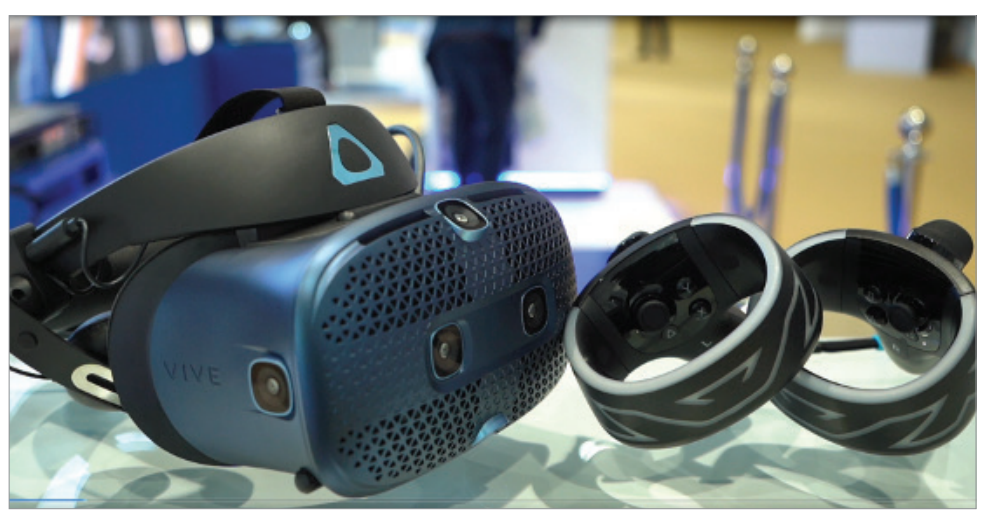
Education in wound care is vital to ensure that healthcare professionals (HCPs) can accurately identify, diagnose and manage wounds, ensuring that they deliver safe and effective care for patients. However, it can be difficult for HCPs to attend training due to logistics and time constraints in busy clinical environments. Additionally, it is a challenge to be able to deliver meaningful training that applies to real world scenarios without putting patients at risk.
Training using virtual reality (VR) and augmented reality (AR) has been used in other medical fields such as surgery for some years. A review of use of VR in surgery (Nassar et al, 2021) concluded that technical skills training should commence outside the operating room on a simulator, with VR found to be successfully used to provide safe training, and to validate and fine-tune acquired skills to achieve proficiency and independent practice. The major strengths of VR compared to other simulation modalities were found to be that it facilitates deliberate practice with built-in auto feedback helping to address limited staff resources (Nassar et al, 2021). An early study (Seymour et al, 2002) also found that use of VR surgical simulation for surgical residents to reach specific target criteria significantly improved their performance during the surgical procedure.
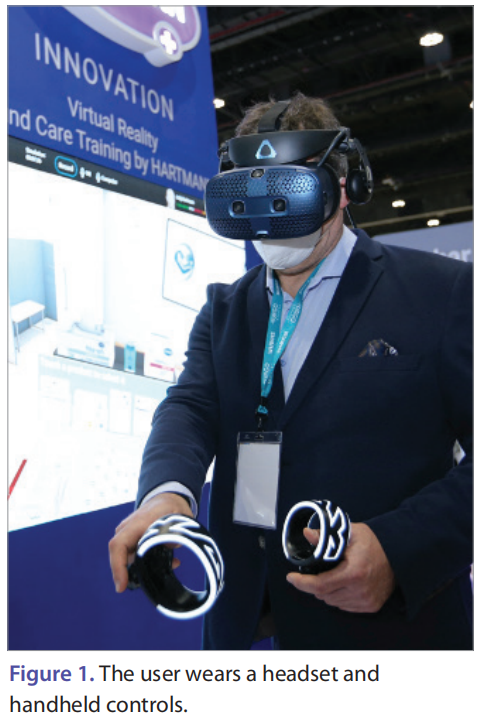
In wound care, VR training can provide a safe and effective means of HCP education in a way that can be applied to real-world practice without causing risk of harm to patients. Use of VR technology can also provide a more flexible form of training for busy HCPs (Ousey et al, 2018). HARTMANN’s Virtual Reality Training Program in Wound Management introduces a new approach to wound care education, using VR simulation to give healthcare professionals a deeper, interactive, and intuitive learning experience.
Additionally, VR-based tools can incorporate ‘checklist-style’ assessment measures to objectively gauge proficiency, taking the process outside the realm of human subjectivity; thus, VR training tools offer a highly granular picture of what HCPs are doing correctly and identify areas for improvement (Blumstein, 2019).
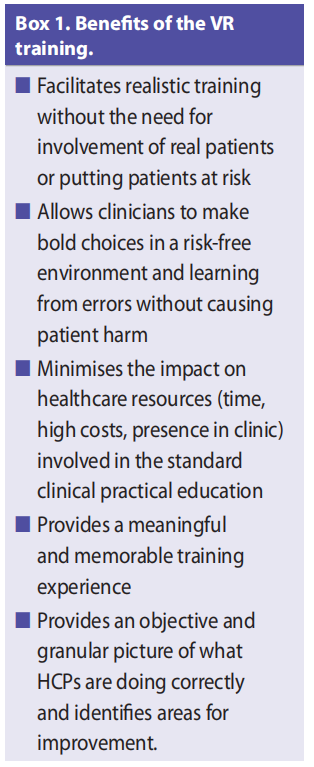

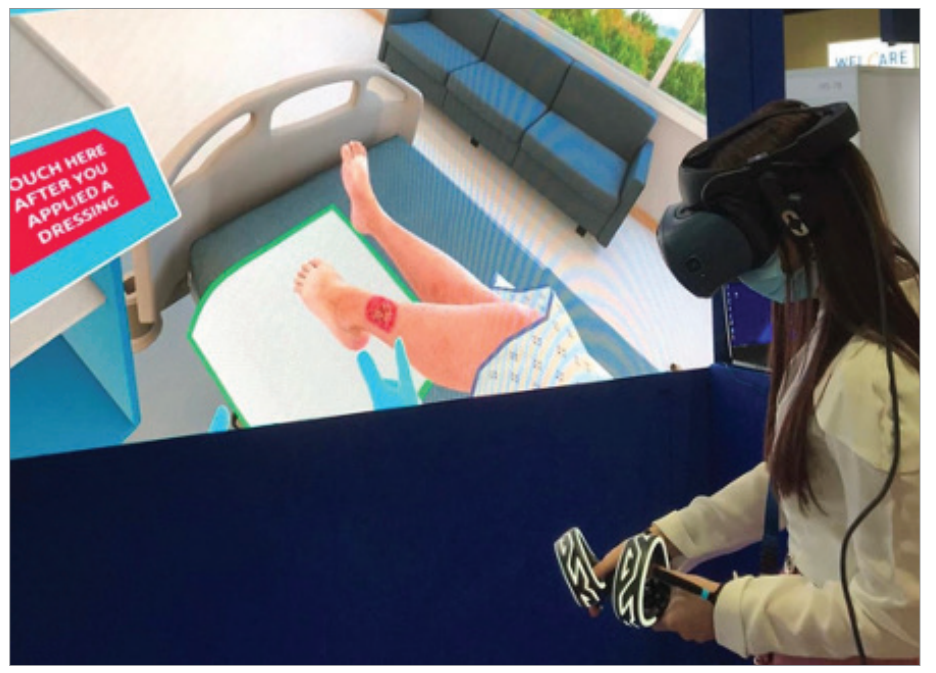
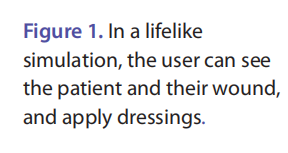
Virtual reality
VR is the computer-generated simulation of a three-dimensional image or environment that can be interacted with in a seemingly real or physical way by a person using special electronic equipment, such as a helmet with a screen inside or gloves fitted with sensors. The capability of today’s VR headsets means that truly immersive virtual experiences are available for the first time in history (Ousey et al, 2018). These technologies are now being adapted for medical education and are enabling further interactivity, immersion, and safety in medical training (Herur-Raman, 2021).
Advancements in VR technology now provide the training necessary for skill acquisition and transfer to real-word practice, such as in surgical procedures (Nassar et al, 2021). A randomised study demonstrated VR training programmes as a more effective modality of learning orthopaedic surgical techniques compared to passive learning tools (Blumstein et al, 2020). The 20 participants were randomised into VR and standard learning groups. All 20 participants completed the first phase and 17 completed the second phase of the study. Aggregate global assessment scores were significantly higher for VR than standard learning group (17.5 versus 7.5, p<0.001), including scores in all individual categories. The percentage of steps completed correctly was significantly higher in the VR group compared to the standard learning group (63% versus 25%, p<0.002). Average improvement between the first and second phases of the study were higher in the VR group compared to the standard learning group across all five categories of the global assessment scale, and significantly higher for knowledge of instruments (50% versus 11%, p<0.01). The authors concluded that VR training was more effective than standard learning in this surgical field.
VR also seems be important tool to learn surgical skills in laparoscopy. Results show that VR learning could highly improve medical students’ performance and enable the participants to obtain flow experience with a lower cognitive load (Yu et al, 2022).
In wound care, VR can provide a very safe method of training in clinical practice, using realistic patient scenarios and wounds without compromising patient safety. VR training can also minimise the impact of resources for HCPs and within departments or institutions — e.g. clinician time, high costs, required presence of patient(s) — that are generally needed in standard clinical practical education.
VR technology can also be used as important part of ‘real’ wound treatment and effectively reduce the pain degree and sensation of patients during wound care procedures, which may also reduce the pharmacological treatment of pain connected with wound dressing (He et al, 2022).
Additionally, it has been proven that the ‘gamification’ of education (i.e. introducing elements that allow the user to ‘win’ at tasks and visibly improve their skills), which is possible through VR, has the potential to enhance levels of learners’ engagement, thus improving their skills and optimising their learning (Smiderle et al, 2020). VR can provide a unique and memorable training experience, which enhances learning. In this instance of wound care training, the VR experience promotes learning, memory recall, and personal satisfaction and enjoyment (which will further increase the motivation of the learner) in completing the training by achieving wound closure.
The HARTMANN Virtual Reality Training Program in Wound Management
The HARTMANN Virtual Reality Wound Care Training offers a unique learning experience based on patented Virtual Reality (VR) Simulation, providing lifelike clinical experience in Wound Management. This patented algorithm of learning offers the first of its kind 3D immersion and simulation with lifelike clinical experience in wound management.
The user has the opportunity to see a patient and their wound, and to select the correct treatment for the individual patient. They will then be able to find out if they made the correct treatment choices, by tracking the wound and its progress over time, conducting dressing changes and choosing continued treatment choices at each stage, and influencing the final outcome.
Crucially, the VR training gives the HCP the chance to be bold in their choices, safely risk ‘getting it wrong’ and learn through trial and error, without compromising patient safety. This provides an opportunity to build clinician confidence and, additionally, the novel experience of using the VR technology makes learning memorable. Using VR technology in wound management helps to improve the perceptive level of training, increasing its relevance to application in real-world practice.
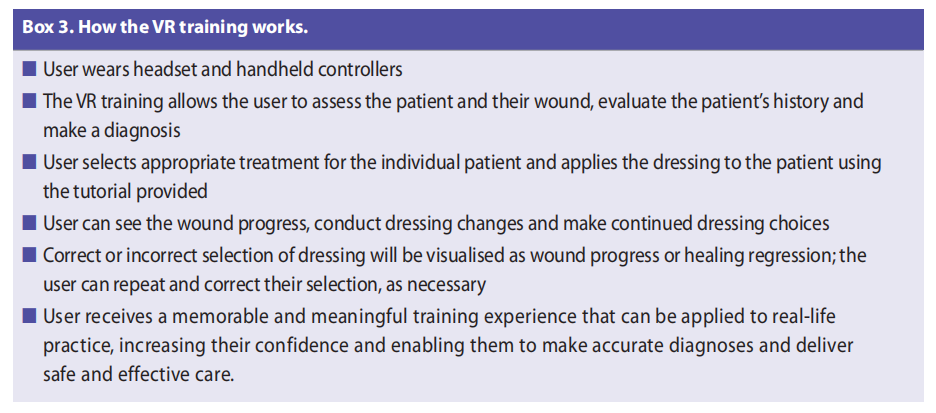
How it works in practice
The VR training modules complement the Wound Management education programmes HARTMANN has already offered to HCPs via seminars, conferences and workshops. The VR modules allow remote, collaborative learning, enhancing either autonomous, peer-to-peer or group learning experiences of HCPs in wound care. The format of the training encourages interactions with peers and open new cooperation between industry and HCPs.
The technology is progressive and easy to use, consisting of a headset and handheld controllers. The VR training scenarios allow HCPs to evaluate patient history, to examine and diagnose the wound type, and to select the dressings considered as the appropriate therapeutic solution for the given healing phase. This way the focus of the VR training is on evaluation, clinical reasoning and decision making, designed to mirror practice in the real world. Clinical reasoning and decision making skills are improved, and the user’s hand movements and possible errors during dressing applications are corrected. The training enables users to go on to identify more easily and correctly the specific wound types more accurately and confidently, and to select the right treatment options for those wounds.
Conclusions
VR is now being used as a powerful tool in medical education, allowing higher levels of interactivity, and the ability to rehearse clinical procedures and refine relevant skills (Herur-Raman, 2021). The HARTMANN Virtual Reality Training Program offers the first 3D immersion and simulation with lifelike clinical experience in wound management, serving as a powerful educational tool and complementing the existing traditional, or advanced digital learning, pathways. The VR technology allows training in a risk free environment, and the opportunity for ‘checklist-style’ assessment can offer a granular picture of what HCPs are doing correctly and identify areas for improvement (Blumstein, 2019).
This pioneering new approach to HCP education will increase clinicians’ skills and confidence and ultimately improve experiences and outcomes for patients. HCPs will be equipped to assess, identify, diagnose and manage wounds based on the patient’s history and described symptoms, selecting treatment options and tracking outcomes.
REFERENCES
1. Blumstein G (2019) Research: How virtual reality can help train surgeons. Harvard Business Review. Available online at: https://hbr.org/2019/10/research-how-virtual-reality can-help-train-surgeons (accessed 6.4.2022)
2. Blumstein G, Zukotynski B, Cevallos N et al (2020) Randomized trial of a virtual reality tool to teach surgical technique for tibial shaft fracture intramedullary nailing. J Surg Educ 77(4): 969-77
3. He ZH, Yang HM, Dela Rosa RD, De Ala MB (2022) The effects of virtual reality technology on reducing pain in wound care: A meta-analysis and systematic review. Int Wound J 10: 1111
4. Herur-Raman A, Almeida ND, Greenleaf W et al (2021) Next generation simulation—Integrating extended reality technology into medical education. Front Virtual Real 2: 693399
5. Nassar AK, Al-Manaseer F, Knowlton LM, Tuma F (2021) Virtual reality (VR) as a simulation modality for technical skills acquisition. Annals of Medicine and Surgery 71: 102945
6. Ousey K, Langley J, Waugh P (2018) Virtual and augmented reality: enhancing nurses’ wound care management skills. Wounds UK 14(2): 8-10
7. Seymour NE, Gallagher AG, Roman SA et al (2002) Virtual reality improves operating room performance: results of a randomized, double-blinded study. Annals of Surgery 236(4): 458-64
8. Smiderle R, Rigo SJ, Marques LB et al (2020) The impact of gamification on students’ learning, engagement and behavior based on their personality traits. Smart Learning Environments 7: 3
9. Yu P, Pan J, Wang Z et al (2022) Quantitative influence and performance analysis of virtual reality laparoscopic surgical training system. BMC Med Educ 22: 92
This article is excerpted from the Wounds International 2022 | Vol 13 Issue 2 by Wound World.


